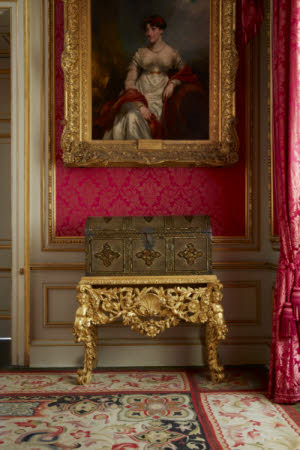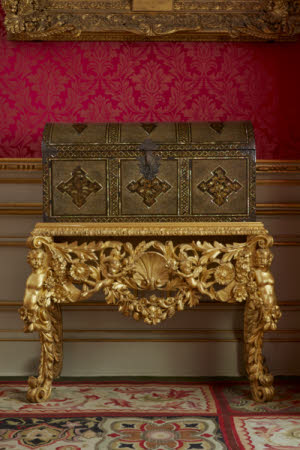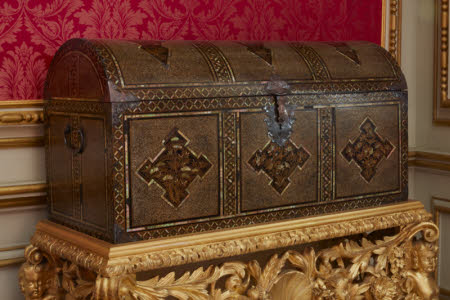Coffer
Category
Furniture
Date
c. 1625 - c. 1645 (the stand c. 1710)
Materials
Wood, lacquer, mother of pearl, ray or sharkskin denticles, silver mounts, gilt deal stand
Place of origin
Kyoto
Order this imageCollection
Belton House, Lincolnshire
NT 435120
Summary
A lacquer coffer decorated with sprinkled gold, ray- or sharkskin denticles and mother-of-pearl, Japanese (made for export to Europe), c. 1625–45, on an associated giltwood stand, English, c. 1710. The coffer with a domed lid, decorated in the namban style with vignettes of flowering trees within 'pine bark diamond' (matsukawa-bishi) frames on a ground of imitation-shagreen (samegawanuri, lacquer sprinkled with the denticles from ray- or sharkskin), separated by bands of geometric mother-of-pearl motifs (imitating the appearance of the metal bands on European coffers), mounted with an engraved silver lockplate, corner mounts and handles, the interior decorated with trailing floral designs and birds. The giltwood stand with a deep carved frieze pierced and carved with putti, flower heads and acanthus, on scrolled legs carved with putti and foliage.
Full description
The so-called namban style of decoration was developed by Japanese lacquer artisans in response to Portuguese demand from about 1580. The word namban, meaning 'southern barbarian', was used by the Japanese to refer to the Portuguese and other Europeans, whose ships arrived in Japan from the south. The use of metal foil and mother of pearl on lacquer had already been developed by the Kōami family of artisans in Miyako (present-day Kyoto) in the fifteenth century, but the Portuguese appear to have requested a particularly dense style of decoration, influenced by their familiarity with the objects inlaid with mother of pearl produced in Gujarat, on the western coast of India. When the Dutch and English began to buy Japanese lacquer in the early seventeenth century, the namban style became slightly less dense. Imitation-shagreen is found on Japanese export lacquer from the mid 1720s. This coffer is illustrated in Emile de Bruijn, Borrowed Landscapes: China and Japan in the Historic Houses and Gardens of Britain and Ireland, London, Philip Wilson Publishers in association with the National Trust, 2023, pp. 21-2 (fig. 4). For the dating of Japanese export lacquer with samegawanuri see Karina H. Corrigan, Jan van Campen and Femke Diercks (eds.), Asia in Amsterdam: The Culture of Luxury in the Golden Age, New Haven and London, Yale University Press in association with the Peabody Essex Museum and the Rijksmuseum, 2015, cat. 38, pp. 155-7. For two similar coffers with banding of mother of pearl and samegawanuri in the collection at Coughton Court, Wiltshire, see Oliver Impey and Christiaan Jörg Japanese Export Lacquer 1580–1850, Amsterdam, Hotei Publishing, 2005, cats. 339 and 340, p. 153. (James Weedon, November 2018, and Emile de Bruijn, November 2023)
Provenance
Purchased by the National Trust at the Belton House sale organised by Sotheby's, 30 April - 2 May 1984, lot 108, with the help of a grant from the National Heritage Memorial Fund. The coffer was purchased with a different gilt and painted stand, now reunited with the lapis lazuli cabinet (NT435082) at Belton. The current giltwood stand for this coffer may possibly be the stand made or adapted for the lapis cabinet when it first arrived in London, c. 1710-15.
References
Jörg and Impey 2005: Christiaan Jörg and Oliver Impey, Japanese Export Lacquer 1580-1850, Amsterdam, 2005








